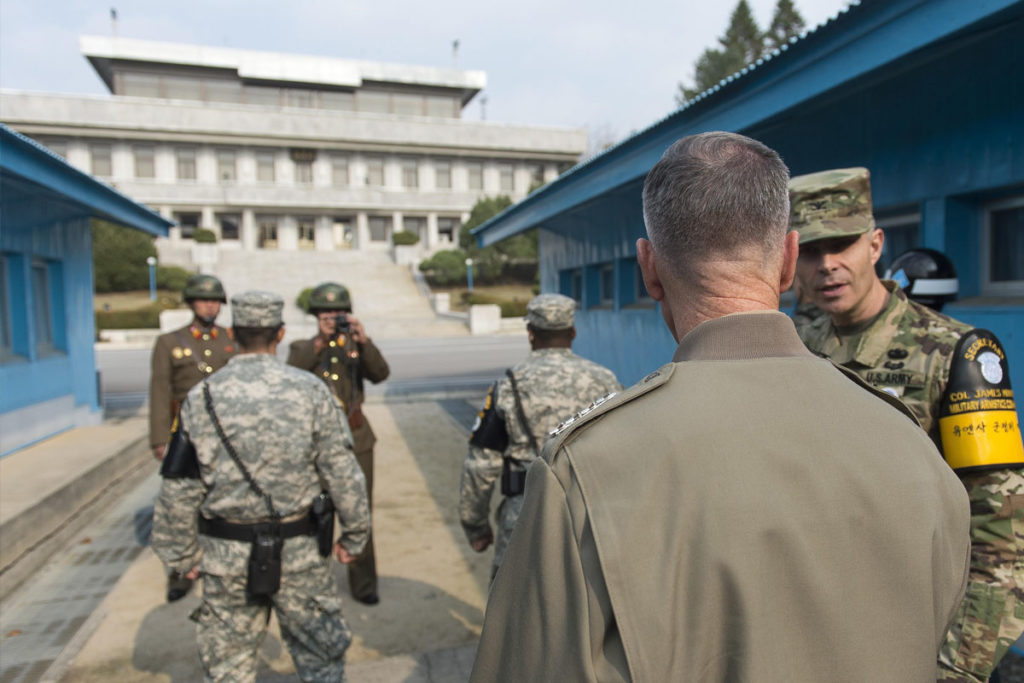Tour programs to the world’s most dangerous border are once again drawing attention following last week’s historic inter-Korean summit advancing peace on the Korean Peninsula.
Over the past few years mainly due to a fiery war of words between North Korea and the United States, the Korean Peninsula seemed to be on the brink of a second Korean War, making people reluctant to travel to the demilitarized zone (DMZ) and decreasing the number of visitors.
However, the sudden peace momentum has seen a return of visitors to the heavily fortified border splitting the two Koreas — the closest South Korean tourists can get to the North — and local governments and tour agencies are wasting no time coming up with various DMZ tour programs.
The DMZ, a 250-kilometer strip of rugged no-man’s land stretching from coast to coast, is the best place for those who want to peek into the reality of the divided Korean Peninsula and view the pristine landscape.
Here are a few options for a visit to the DMZ.
☞ Find and Book your Korea DMZ/JSA Tours and Activities
Panmunjeom
Panmunjeom, also known as the Joint Security Area (JSA), has regained global attention after serving as the venue for the April 27 meeting between President Moon Jae-in and his northern counterpart Kim Jong-un.
The border truce village is the only place in the world where soldiers from the two countries stand face-to-face. In addition, it has a historical significance as the armistice agreement was signed here on July 27, 1953.
Plus, U.S. President Donald Trump has hinted at holding a summit there with the North Korean leader, in which case the place may draw the greatest attention ever.
When Trump paid a state visit to Korea last year, he attempted to make a “surprise” visit to the DMZ, which was scrapped due to bad weather. At the time, he was described as “pretty frustrated” that his visit did not go ahead.
Visiting Panmunjeom is only available through tour groups comprised of 30 to 45 visitors. It is open to those aged 10 and above.
For South Koreans, they are required to apply and register for the Panmunjeom tour program through the National Intelligence Service 60 days ahead of their tour dates. However, foreigners can reserve a minimum of three days in advance — through United Nations Command-designated travel agencies — in order to receive security clearance.
Panmunjeom tours are available from Tuesday through Saturday with three sessions per day. They are also closed on national holidays or due to major events such as the summits.
Visitors are prevented from wearing torn denim pants, uniforms, T-shirts, shorts, miniskirts and clothing exposing a lot of skin or similar clothes. They are not allowed to bring drinks or alcohol.
Tourists have to keep their ID cards with them at all times.
☞ Find and Book your Korea DMZ/JSA Tours and Activities
Imjingak Resort
Imjingak, located 7 kilometers from the Military Demarcation Line, is a leading place for Korean War-related tourism.
The three-story pavilion was built in 1972 in a move to console families divided by the three-year war and has many statues and monuments regarding the war.
The resort also features Mangbaedan Alter, where the separated families perform ancestral rites on traditional holidays, and the Bridge of Freedom, used by repatriated prisoners of war and soldiers returning from North Korea after the armistice agreement.
Unlike Panmunjeom, visitors can enjoy the resort without passing any security checkpoints and it is open all year round.
Plus, those who want to tour Dora Observatory and the Third Tunnel have to make a reservation in advance at the ticket box in the Imjingak parking lot.
Dorasan Station, Dora Observatory, Third Tunnel
Dorasan Station is the northernmost point of South Korea’s rail network, located within the civilian-restricted area. It opened in April 2002 on the back of then-President Kim Dae-jung’s “Sunshine Policy” of engagement with Pyongyang.
Dorasan Station can be reached through the Gyeongui Line from Seoul Station and it is within the Civilian Control Line, so visitors have to go through security procedures at Imjingang Station to take the train there.
Near the station are the Dora Observatory and the Third Tunnel. Visitors without a valid identification card cannot enter the civilian-restricted area and foreign tourists must bring a passport. They can tour the attractions by shuttle bus, guided by soldiers. Individual tours are unavailable and private vehicles are not allowed.
The observatory allows visitors to catch a glimpse of their northern neighbor and various locations including Gaeseong, a massive statue of Kim Il-sung and the North Korean village of Kijong-dong, the North’s propaganda village. The observatory offers 500 seats, VIP rooms and abundant parking.
Its operating hours are from 9 a.m. to 3 p.m. and the observatory is closed on Mondays and national holidays as well as the Lunar New Year and Chuseok.
The tunnel, discovered in 1978, spans over 1.6 kilometers in length, 2 meters in width and 2 meters in height. It is estimated 30,000 soldiers per hour could move through the tunnel in the event of an invasion.
Visitors can see inside the tunnel by either walking or riding a monorail. The first tour to the tunnel begins at 9:20 a.m. and the last shuttle departs at 3:30 p.m.
Source: THE KOREA TIMES
